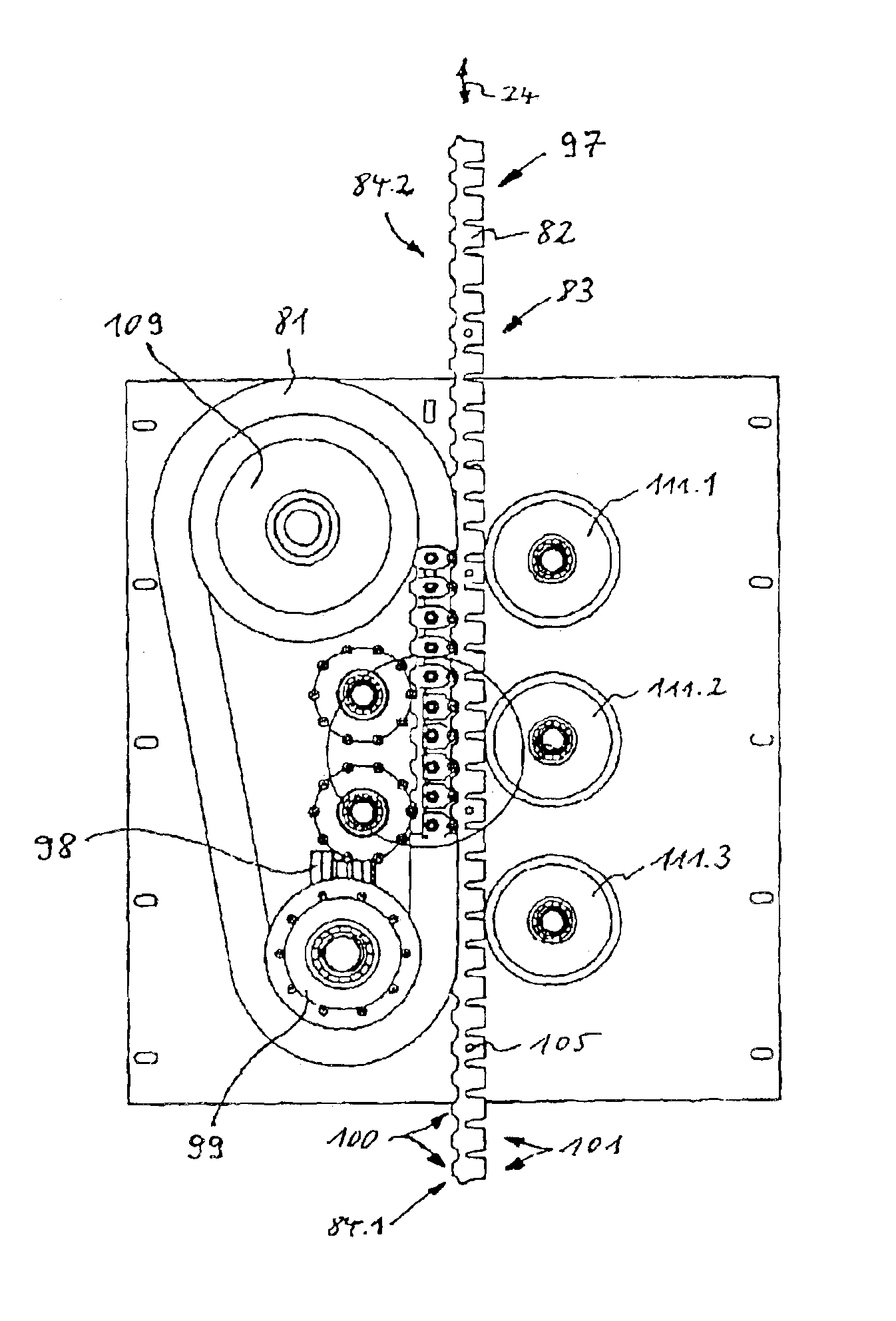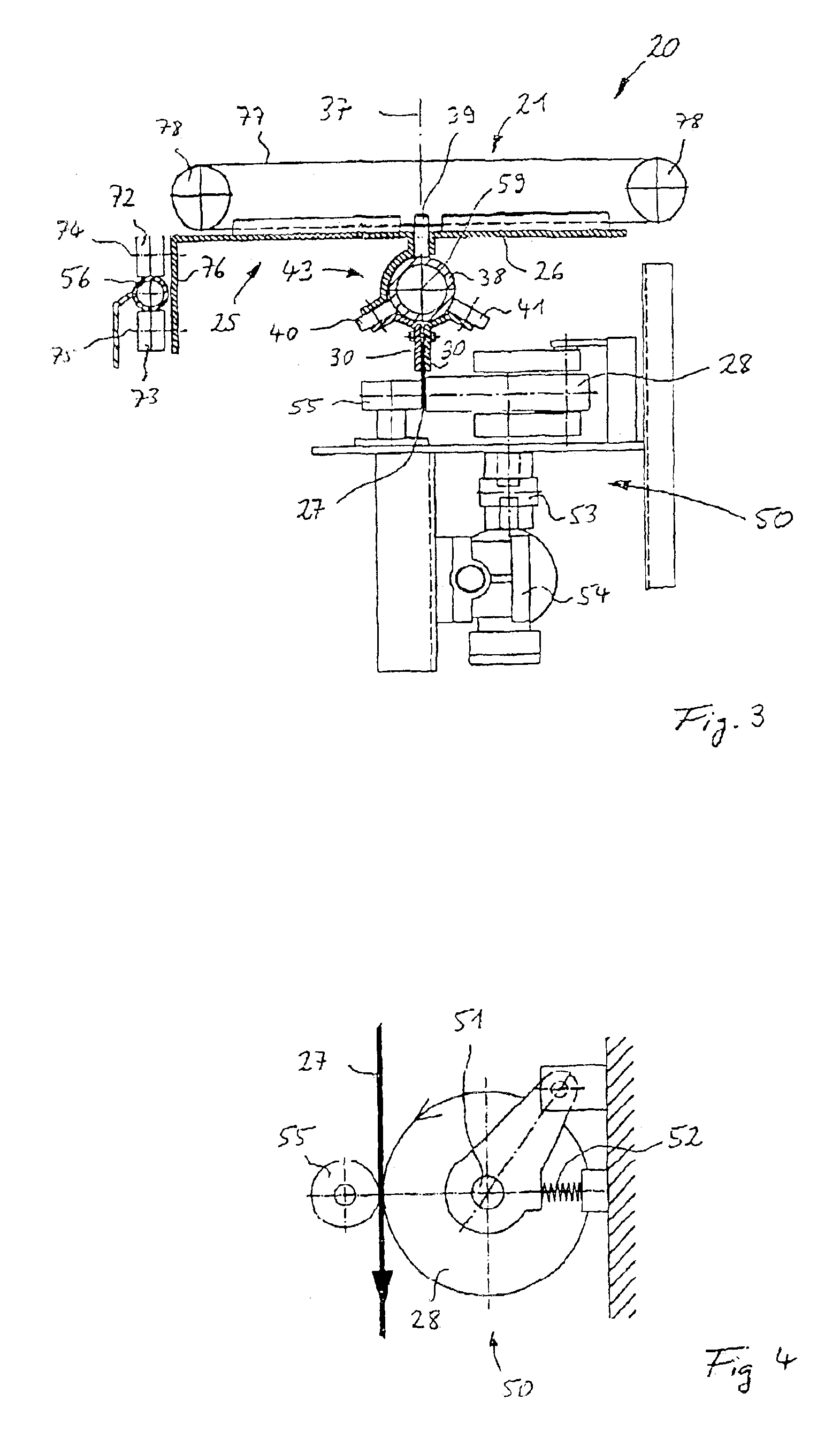[0012]Another
advantage of the invention is that the driving belt does not have to be made endless at the point Of the joint, but that both ends can be clamped in on the clamping profiles so that these ends rest against each other in a butt-joined way. In the clamped-in condition, the clamping forces acting between the clamping jaws, which oppose each other, and can consequently ensure not only the connection between the individual conveying and sorting systems and the driving belt. These clamping forces can also be used for creating an inexpensive, a particularly simple connection of the ends of the driving belt to form an endless belt. Thus, it is possible to obtain a particularly flexible application of all kinds of different constructions.
[0013]The driving belt, and consequently also the conveying device and the conveying and sorting systems, are usefully driven with the help of a friction
wheel drive that is preferably realized in the form of the type of the proportional drive that is already known from DE 42 44 170 C2 incorporated herein by reference.
[0014]In another variation of the second alternative of the solution, the driving belt can be formed as a flat, flexible belt which, is reinforced with a tensile element of high strength that is extended all around in the area where its edge is clamped in a fixed manner by the clamping jaws of the respective clamping profile. Accordingly, in another beneficial embodiment of the first alternative of the solution, the driving belts are each reinforced with a tensile element of high strength that extends all around or all through. A steel cable comprised of stranded steel wire can preferably be used in each case for this purpose. On the other hand, the belt surrounding the tensile element, as in the case where no such reinforcement is used, preferably consists of a plurality of
layers of fabric, for example of a
polyester fabric. These
layers comprise intermediate and cover
layers as well. The layers, which point away from each other and form the external surface of the driving belt, preferably consist of
polyurethane. Such a driving belt is flexible like the shafts for a horse. The above measures permit particularly favorable clamping conditions to be obtained and even more flexible movements in the vertical direction. The length of the belt corresponds with the overall length of the conveying line.
[0015]Another beneficial feature of both alternatives of the solution, provides that the clamping profiles can be formed as long-stretching clamping bars that extend in parallel with the driving belt. The clamping jaws of these clamping bars extend substantially over the total length of the clamping bars. Thus, in the clamped, fixed condition, the clamping jaws solidly abut or clamp substantially over the entire length of the clamping bars. This, in turn, means that further enhanced conveying and driving conditions are achieved, and that the maintenance intervals are also prolonged.
[0016]In another beneficial variation of both alternatives of the solution, the conveying systems can be formed as traveling carriages equipped with running rollers that are guided on a preferably central guide rail of the conveying line, which is arranged in the area of the transverse center of the respective conveying and sorting system, and which extends in the direction of conveyance. It is thus possible to always achieve constantly good guiding conditions, combined with favorable construction possibilities and low manufacturing tolerances, also when confronted with difficult conditions of curves, and even with conveying lines that intersect each other. Furthermore, it is possible by means of the measures specified above, to adjust in a simple manner a slanted position or inclination of the conveying system that is flexibly adapted to the application and user requirements, if necessary jointly with the sorting system, to be able to compensate for the centrifugal forces occurring when traveling through curved sections of the conveying line.
[0017]The traveling
carriage can be is guided via at least three running rollers that are arranged at an angle of preferably 120 degrees around the longitudinal axis of the guide rail. This permits particularly favorable guiding and conveying conditions, along with a low-
noise and low-maintenance operation over a long period of time. The running rollers can be formed as an arrangement gripping (or extending) around the guide rail, so that it is possible to support both the weight of the traveling
carriage and to obtain support for the traveling
carriage versus the force of gravity. This permits safe guidance and conveyance of the traveling carriages, if need be also when the traveling carriages are in a position that is inclined versus the horizontal line. This design makes the device able to satisfy the requirements to be met with respect to difficult conditions in curves in particular in the presence of elevated conveyance capacities.
 Login to View More
Login to View More  Login to View More
Login to View More 


